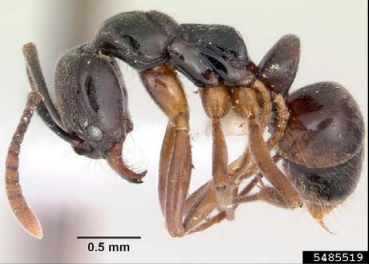Invasive Pests
Invasive pests (plants, insects, diseases, and others) cause enormous economic damage, as well as environmental damage. These displace or destroy beneficial and native plants and animals, reduce biodiversity. The annual economic cost is estimated at $1 billion in VA alone, more than $120 billion in the US.
If you think you see the following pest, which is not yet known to occur in Bedford County, please contact the Bedford Master Gardeners at bedfordmg@vt.edu or 540-586-7675. If you are outside of Bedford County, please contact your local Virginia Cooperative Extension Office.
Invasive Pest #7 – Asian Needle Ant, Brachyponera (=Pachycondyla) chinensis
The Asian needle ant is an invasive species native to China, Japan, and Korea. It currently is known to occur in the southeastern US, including parts of eastern Virginia, and as far north as New York and Wisconsin. (Ref 1). It likely has been in Virginia for decades but has not been noticed or has been thought to be imported fire ants. While it is a small dark brown to black ant, with lighter brown legs and mandibles, it has a large stinger. The venom delivered through the stinger can be a major allergen to people who are sensitive to insect stings. Due to the painful nature of the sting, it is sometimes confused with the red imported fire ant. Unlike fire ants, the Asian needle ant sting can result in anaphylaxsis similar to that caused by honeybee stings, or swelling or hives, but not the raised blisters seen from fire ants (Ref 1, 3, 4). This ant is not aggressive, and most stings occur when someone reaches into a nest.

This ant is a leaf litter inhabitant and a general scavenger. It will inhabit both disturbed and undisturbed areas, unlike fire ants. It does not make mounds. In nature, the ants can be found in damp areas below stones or rotting logs. Asian needle ants are also found in residential settings, parks, and urban areas, where they occur in mulch and under railroad ties, logs, bricks, and pavers. They can nest in potted plants, under wood piles, and in lawns. The ants have been reported to forage inside homes and buildings and may pose a problem as residential invaders in the future. (Ref 1, 2). In fact, the preferred food of this ant appears to be termites, but it also will feed on a variety of other organisms (Ref 4).
The potentially greatest negative impact posed by the Asian needle ant is its potential to devastate a natural environment by excluding native ant species and termites. (Ref 2, 3). Researchers have reported that the Asian needle ant displace species of native ants, reducing biodiversity and upsetting the natural balance in the ecosystem. Plant species dependent on native ant species to spread their seeds do not have the same relationship with this exotic ant and their distribution may be limited by this.
This species does not appear to use pheromone trails to attract fellow workers to food sources. Instead, they physically carry another worker to where the food is located. (Ref 2, 4). As a result, most baits do not work well.
According to NCSU, Asian needle ants can also be distinguished from other ants because they have an inability to cling to smooth surfaces like glass. By carefully capturing an Asian needle ant in a glass jar, one can observe that, unlike other ants that will climb the sides of the jar, the Asian needle ant will make a few futile attempts to climb before confining itself to the base of the jar. (Ref 2)
References (confirmed 9/9/2023)
1. https://www.pubs.ext.vt.edu/content/dam/pubs_ext_vt_edu/ENTO/ENTO-29/ENTO-554.pdf
2. https://content.ces.ncsu.edu/asian-needle-ant-around-landscape-and-home
3. https://www.srs.fs.usda.gov/pubs/su/su_srs143.pdf
4. https://epp.tennessee.edu/wp-content/uploads/2022/05/2022-05AsianNeedleAnt.pdf
Submitted by Betsy B. Extension Master Gardener Volunteer and Help Desk Coordinator.